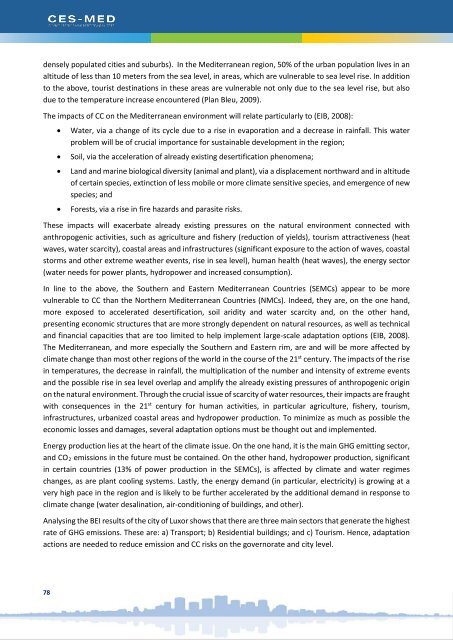280218_Luxor-Egypt SECAP Final_revised
Create successful ePaper yourself
Turn your PDF publications into a flip-book with our unique Google optimized e-Paper software.
densely populated cities and suburbs). In the Mediterranean region, 50% of the urban population lives in an<br />
altitude of less than 10 meters from the sea level, in areas, which are vulnerable to sea level rise. In addition<br />
to the above, tourist destinations in these areas are vulnerable not only due to the sea level rise, but also<br />
due to the temperature increase encountered (Plan Bleu, 2009).<br />
The impacts of CC on the Mediterranean environment will relate particularly to (EIB, 2008):<br />
• Water, via a change of its cycle due to a rise in evaporation and a decrease in rainfall. This water<br />
problem will be of crucial importance for sustainable development in the region;<br />
• Soil, via the acceleration of already existing desertification phenomena;<br />
• Land and marine biological diversity (animal and plant), via a displacement northward and in altitude<br />
of certain species, extinction of less mobile or more climate sensitive species, and emergence of new<br />
species; and<br />
• Forests, via a rise in fire hazards and parasite risks.<br />
These impacts will exacerbate already existing pressures on the natural environment connected with<br />
anthropogenic activities, such as agriculture and fishery (reduction of yields), tourism attractiveness (heat<br />
waves, water scarcity), coastal areas and infrastructures (significant exposure to the action of waves, coastal<br />
storms and other extreme weather events, rise in sea level), human health (heat waves), the energy sector<br />
(water needs for power plants, hydropower and increased consumption).<br />
In line to the above, the Southern and Eastern Mediterranean Countries (SEMCs) appear to be more<br />
vulnerable to CC than the Northern Mediterranean Countries (NMCs). Indeed, they are, on the one hand,<br />
more exposed to accelerated desertification, soil aridity and water scarcity and, on the other hand,<br />
presenting economic structures that are more strongly dependent on natural resources, as well as technical<br />
and financial capacities that are too limited to help implement large-scale adaptation options (EIB, 2008).<br />
The Mediterranean, and more especially the Southern and Eastern rim, are and will be more affected by<br />
climate change than most other regions of the world in the course of the 21 st century. The impacts of the rise<br />
in temperatures, the decrease in rainfall, the multiplication of the number and intensity of extreme events<br />
and the possible rise in sea level overlap and amplify the already existing pressures of anthropogenic origin<br />
on the natural environment. Through the crucial issue of scarcity of water resources, their impacts are fraught<br />
with consequences in the 21 st century for human activities, in particular agriculture, fishery, tourism,<br />
infrastructures, urbanized coastal areas and hydropower production. To minimize as much as possible the<br />
economic losses and damages, several adaptation options must be thought out and implemented.<br />
Energy production lies at the heart of the climate issue. On the one hand, it is the main GHG emitting sector,<br />
and CO 2 emissions in the future must be contained. On the other hand, hydropower production, significant<br />
in certain countries (13% of power production in the SEMCs), is affected by climate and water regimes<br />
changes, as are plant cooling systems. Lastly, the energy demand (in particular, electricity) is growing at a<br />
very high pace in the region and is likely to be further accelerated by the additional demand in response to<br />
climate change (water desalination, air-conditioning of buildings, and other).<br />
Analysing the BEI results of the city of <strong>Luxor</strong> shows that there are three main sectors that generate the highest<br />
rate of GHG emissions. These are: a) Transport; b) Residential buildings; and c) Tourism. Hence, adaptation<br />
actions are needed to reduce emission and CC risks on the governorate and city level.<br />
78

















